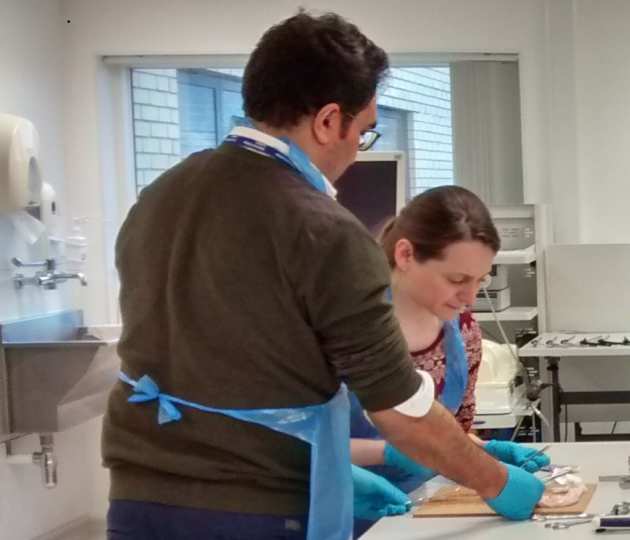 The London School of Surgery Training Programme is designed to provide laboratory training specifically matched to the trainee's stage in clinical practice. As trainees progress from ST4 to ST5, or move sub-specialty, the programme has the flexibility to switch trainees into more appropriate training. The training sessions are distributed at approximately monthly intervals.
The London School of Surgery Training Programme is designed to provide laboratory training specifically matched to the trainee's stage in clinical practice. As trainees progress from ST4 to ST5, or move sub-specialty, the programme has the flexibility to switch trainees into more appropriate training. The training sessions are distributed at approximately monthly intervals.
For London ST3s and ST4s, the training sessions cover a wide-range of procedures at which junior general surgical trainees might be expected to achieve competency (see General/Junior Procedures).
For ST5s and ST6s, training is focused on the sub-specialty of the trainee's clinical post - specifically Breast, Colorectal, Upper GI and HPB, Transplant and Vascular (see below).
All training sessions are taught by experienced consultants. Their contribution is greatly valued by the trainees.
Curriculum Accordion widget
- General Junior procedures
- Breast procedures
- Colorectal procedures
- Transplant procedures
- Upper GI/HPB procedures
- Vascular procedures
General Junior trainees will be expected to perform:
- Hand-sewn and stapled bowel anastomosis – using porcine bowel and hand-sewn technique
- Laparoscopic suturing – using box-trainers to allow practice of stitching and knot tying techniques on a range of substrates, including both tissue and synthetic skin pads
- Stoma formation and siting – using porcine bowel and skin
- Laparoscopic cholecystectomy – using a porcine tissue model. This model allows for division, mobilisation and ligation of the vessels and use of diathermy to remove the gall bladder.
- Open inguinal and femoral hernia repair – using a model developed by the programme which offers more realistic anatomical landmarks, as well as dissection of the spermatic cord and mesh placement/fixation
- Laparoscopic gastrojejunostomy – focusing on stapling technique and continuous stitching
- Hand-sewn and stapled colorectal anastomosis – using porcine large bowel in conjunction with pelvic jigs supplied by Annex Art. Hand-sewn technique
- Basic vascular anastomosis – latex artery models that allow for end-to-end, longitudinal and transverse anastomoses
- Open gastrojejunostomy and surgical management of emergency upper gastrointestinal procedures - using hand-sewn technique on porcine stomach and small bowel, on a bench-top model
There will also be an opportunity to attend an optional Energy Sources in Surgery Workshop.
Trainees attached to an ST5 or ST6 Breast post will be expected to perform:
- Wide local excision
- Wire-guided surgery
- Breast imaging and needle localisation/biopsy
- Axillary lymph node clearance
- Nipple reconstruction
- Lipomodelling
- Mammoplasty
- LICAP flap reconstruction
- Magnetic seed localisation
Trainees attached to an ST5 or ST6 Colorectal post will be expected to perform:
- Laparoscopic suturing– using box-trainers to allow practice of stitching and knot tying techniques on a range of substrates, including both tissue and synthetic skin pads
- Hand-sewn coloanal anastomosis – using porcine bowel on bench-top simulators, and allowing training with the Eisenhammer retractor
- Laparoscopic TAPP inguinal hernia repair - using Professor Dietz's synthetic model
- Rectal prolapse surgery - Delorme’s procedure
- Laparoscopic right hemicolectomy - using the Programme's synthetic model
- Hand-sewn and stapled ileoanal pouch formation - using porcine bowel to create a pouch on the bench-top
- Haemorrhoid surgery and treatments
There will also be an opportunity to attend an optional Proctological Workshop - trainees will cover lateral sphincterotomy, fissure, pilonidal disease, and anal fistula.
Trainees attached to an ST5 or ST6 Transplant post will be expected to perform:
- Benching - back table kidney preparation
- Ureteric techniques - standard, duplex, etc
- Vascular anastomoses- anastomotic techniques on arteries and veins, vein elongation techniques, living/deceased donor vessels, single/multiple vessels, etc
- Vascular access surgery
- Full abdominal retrieval and benching
- Pancreatic anastomoses
Trainees attached to an ST5 or ST6 Upper GI or HPB post will be expected to perform:
- Laparoscopic perforated peptic ulcer repair
- Laparoscopic suturing – using box-trainers to allow practice of stitching and knot tying techniques on a range of substrates, including both tissue and synthetic skin pads
- Biliary bypass surgery
- Laparoscopic TAPP inguinal hernia repair - using Professor Dietz's synthetic model
- Hand-sewn oesophagogastric anastomosis – using a jig to simulate depth and the awkward angles involved in this procedure. Parachute technique can also be used
- Laparoscopic fundoplication and Heller’s myotomy – using a hybrid porcine tisuue and synthetic model allowing manoeuvring of the fundus around the oesophagus via manipulation through the crus
- Laparoscopic common bile duct exploration - using choledochoscopes and baskets to extract foreign bodies from porcine tissue
- Pancreatic anastomoses
Trainees attached to an ST4, ST5 or ST6 Vascular post will be expected to perform:
- Femoral popliteal bypass – using a synthetic model from Limbs and Things
- Open abdominal aortic aneurysm repair– using a synthetic model from Limbs and Things, incorporating aortic, common iliac and internal iliac aneurysms
- Carotid endarterectomy– involving removal of a plaque from a synthetic filled carotid artery and subsequent arterial repair
- Endovascular aneurysm repair workshop or Peripheral endovascular interventions workshop - double session (all day)
- Vascular access surgery - using a synthetic model
- Femoro-peroneal anastomosis– using a synthetic model from Limbs and Things to practice open techniques
There will also be an opportunity for trainees to attend an optional Renal Transplant workshop.